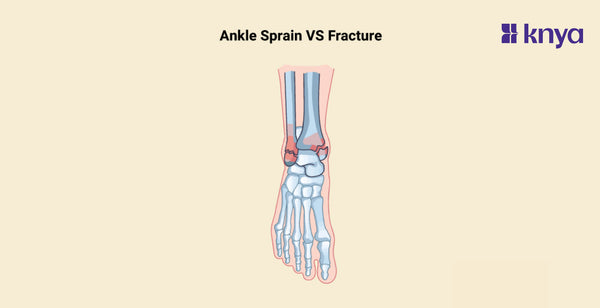Ankle Sprain vs Fracture: Ankle sprains are caused by straining or ripping the ligaments that stabilise the joint, resulting in discomfort, swelling, and bruising on the outside of the ankle. Fractures are genuine fractures in one of the three ankle bones, which are frequently accompanied by acute pain, deformity, inability to bear weight, and, occasionally, a popping sound. While both can result from similar errors, such as twisting or rolling the ankle, sprains usually heal within weeks with RICE (rest, ice, compression, elevation) and physical therapy, whereas fractures require medical treatment, occasionally surgery, and a months-long healing process.
Difference Between Ankle Sprain and Fracture
Both an ankle sprain and an ankle fracture can damage the ankle joint, although they involve separate structures and have unique features. Following are the differences given below:
|
Feature |
Ankle Sprain |
Ankle Fracture |
|
Nature of Injury |
Stretching or tearing of ligaments |
Break or crack in one or more bones |
|
Cause |
Twisting or rolling of the ankle |
Direct impact or force, like a fall or heavy object |
|
Symptoms |
Pain, swelling, bruising, difficulty moving |
Similar, may include visible deformity in severe cases |
|
Diagnostic Methods |
Physical examination, imaging in severe cases |
X-rays for identification of location and extent |
|
Treatment |
R.I.C.E (Rest, Ice, Compression, Elevation), PT |
Immobilization (casting/surgery) followed by rehabilitation |
|
Recovery Time |
Generally shorter |
Variable, depends on severity and treatment |
|
Long-Term Effects |
Minimal if treated appropriately |
May include arthritis or joint stiffness depending on severity |
|
Complications |
Rare, chronic instability in some cases |
Malunion, nonunion, nerve damage |
|
Risk Factors |
Common in athletes, especially those in certain sports |
More common in older individuals, weakened bones |
|
Recurrence |
More prone to recurrence if not fully healed |
Less common, but possible if residual weakness or instability |
What is Ankle Sprain?
An ankle sprain is a tear or stretch of the ligaments that support the ankle joint. It's a common injury caused by rolling or twisting the ankle. Symptoms include pain, swelling, bruising, and difficulty putting weight on the ankle. Most sprains heal within a few weeks with rest, ice, compression, and elevation (RICE).
Key Features of Ankle Sprain:
- Swelling and pain are usually concentrated in the outside ankle (lateral malleolus) or the inner ankle (medial malleolus). Swelling may worsen over time and feel warm to the touch.
- Difficulty and tenderness Bearing Weight: It is painful to touch the wounded region, and placing weight on the afflicted ankle is difficult, resulting in limping.
- Due to ligament injury, it is painful to move the ankle joint, limiting typical mobility such as rolling or bending the foot.
- This may emerge later, beginning as a reddish-purple ring around the ankle and gradually dying out.
What is Fracture?
An ankle fracture is a break in one or more of the bones that make up the ankle joint. It's usually caused by a more severe injury than a sprain, such as a fall or a direct blow to the ankle. Symptoms include severe pain, swelling, bruising, deformity of the ankle, and inability to bear weight. Ankle fractures often require medical treatment, such as casting or surgery, and can take several months to heal completely.
Key Features of Fracture:
- Severe pain is typically characterised as abrupt and acute, making it difficult or highly unpleasant to place any weight on the ankle.
- The ankle may seem noticeably deformed or out of alignment when compared to a healthy ankle.
- Excruciating pain upon contacting the probable fracture location. A crackling feeling may be felt or heard in some circumstances when shattered bone particles move.
- Difficulty or full inability to move the ankle joint owing to shattered bone fragments interfering with mobility.
Shop Best Lab Coats from Here!
Similarities between Ankle Sprain and Fracture
- Pain: Both ankle sprains and fractures cause pain around the affected area.
- Swelling: Swelling is a common symptom for both injuries.
- Bruising: Bruising may occur in both ankle sprains and fractures.
- Difficulty Walking: Both injuries can make it difficult to bear weight on the affected ankle.
- Imaging Studies: X-rays and other imaging studies are used to diagnose both ankle sprains and fractures.
Though both are frequently caused by twists or falls, distinguishing between an ankle sprain and a fracture can be difficult. The essential distinction is that sprains assault the ligaments, which are the strong bands that link bones, whereas fractures penetrate the bones itself. This divergence results in a variety of symptoms. Sprains often result in localised pain, edema, and soreness around the soft tissue, with some weight bearing often permitted despite discomfort. Fractures, on the other hand, frequently cause excruciating pain, quick and considerable swelling, and trouble bearing weight on the damaged ankle. In extreme situations, the form of the ankle may seem skewed. While both require prompt medical treatment, a fracture necessitates rapid intervention owing to the potential of consequences such as bone misalignment or nerve damage. Remember, when in doubt, err on the side of caution and seek professional assessment to ensure your ankle heals as smoothly and completely as possible.
| Check out More Articles | |
| Difference Between Psychosis and Neurosis | |
| Dorsal Vs Ventral | |
| Difference Between Striated and Unstriated Muscles | |















